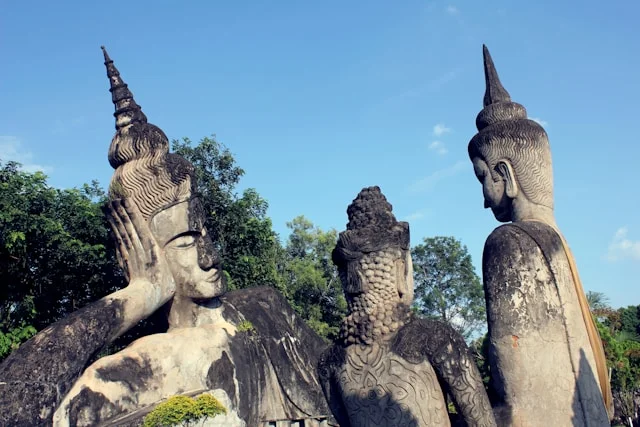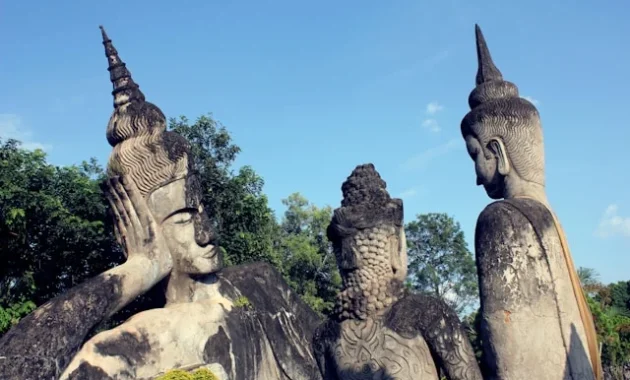
Vientiane, the tranquil capital of Laos, offers an array of cultural experiences, but few are as captivating as Buddha Park, also known as Xieng Khuan. Nestled along the Mekong River, about 25 kilometers southeast of the city, Buddha Park is a unique collection of religious sculptures that blend elements of Buddhism and Hinduism. Its enigmatic nature, coupled with the striking artistry of the sculptures, makes it a must-visit for both tourists and locals alike.
The History and Vision of Buddha Park
Buddha Park was created in 1958 by Luang Pu Bunleua Sulilat, a spiritual leader who sought to merge the religious philosophies of Buddhism and Hinduism. His vision was not to merely create a serene park but to offer a visual representation of the complex beliefs that intertwine these two ancient religions. The park houses more than 200 statues, each carefully designed with symbolic meanings, reflecting Sulilat’s mystical vision and deep spiritual knowledge.
Sulilat later fled to Thailand following political turmoil, where he created a similar park, Sala Keoku, just across the border from Laos. The creation of these parks has led to a spiritual and artistic connection between the two countries, offering a glimpse into Sulilat’s enigmatic persona and his lasting impact on both Laos and Thailand.

Exploring the Sculptures: A Journey Through Myth and Legend
The Giant Pumpkin: A Path to Enlightenment
The most iconic structure in Buddha Park is the giant, pumpkin-shaped sculpture. This massive, three-story monument symbolizes the three levels of existence: hell, earth, and heaven. Visitors can enter the sculpture through a gaping demon’s mouth, ascending through the various levels via an internal staircase.
On the first floor, visitors encounter depictions of hell, with macabre sculptures representing suffering souls. As you move to the second floor, you experience the world of earthly existence, filled with human struggles and joys. Finally, the third floor represents heaven, where ethereal beings and deities dwell in peace. At the very top of the pumpkin, a small platform offers panoramic views of the park, reinforcing the concept of enlightenment and the broader vision of life’s journey.
The Reclining Buddha: Serenity in Stone
The largest statue in the park is the reclining Buddha, stretching nearly 40 meters in length. Unlike traditional depictions, this Buddha appears in a state of calm reflection, symbolizing the moment of Nirvana, or spiritual liberation. It is an awe-inspiring sight, inviting visitors to pause and reflect on their own spiritual journeys.
The reclining Buddha dominates the landscape, and its intricate carvings showcase the artist’s attention to detail. This statue is not merely a representation of Buddha but a complex symbol of the impermanence of life, the quest for inner peace, and the ultimate release from the cycle of rebirth.
Hindu Deities and Mythical Creatures
In addition to the Buddhist imagery, Buddha Park is home to numerous Hindu deities, including statues of Shiva, Vishnu, and Arjuna. These figures represent the blend of religious traditions that Luang Pu Bunleua Sulilat sought to encapsulate in his work. The statues are not only striking in their design but also rich in symbolic meaning, representing the themes of creation, destruction, and preservation.
Mythical creatures, such as Nagas (serpentine beings), are also prevalent throughout the park. These creatures often appear as protectors of temples in both Buddhist and Hindu cultures, symbolizing water and fertility. Their presence in Buddha Park adds another layer of complexity to the site, as they intertwine with the religious motifs to create an otherworldly atmosphere.
The Symbolism Behind the Art
Buddha Park is not merely an outdoor museum of religious sculptures; it is a place where deep symbolism runs through every piece of art. Each statue is a fusion of Buddhist and Hindu philosophies, often designed to make visitors contemplate the nature of existence, suffering, and enlightenment. Many of the figures depict scenes from the Ramayana, an ancient Hindu epic that also plays a significant role in Southeast Asian Buddhist cultures.
The skeleton figures found in several areas of the park remind visitors of the transient nature of life, echoing the Buddhist teaching that all things are impermanent. Meanwhile, the intricate carvings of gods and goddesses show the power of faith, meditation, and morality. These spiritual undertones make Buddha Park more than just a sightseeing location; it is a deeply contemplative space, encouraging visitors to meditate on the meaning of life and the path to spiritual freedom.
The Atmosphere: A Peaceful Respite from the City
While Vientiane is known for its laid-back vibe, Buddha Park offers a different kind of tranquility. The park’s location along the Mekong River adds to its peaceful ambiance, providing visitors with stunning views of the river and the distant Thai border. The lush greenery surrounding the park creates a serene backdrop, enhancing the sense of calm and introspection that the park evokes.
Visitors often come to the park for a quiet day trip from the bustling city, taking time to wander through the sculptures at their own pace. The blend of nature and art makes it an ideal place for reflection, offering a peaceful contrast to the city’s urban sprawl. Whether you’re a devout Buddhist, a spiritual seeker, or simply a traveler looking for a unique cultural experience, Buddha Park offers something for everyone.
How to Get to Buddha Park
Reaching Buddha Park from Vientiane is fairly easy. Visitors can take a tuk-tuk, motorbike, or a local bus from the city center. The bus ride takes around 45 minutes and is an inexpensive option for those on a budget. For those looking for a more comfortable journey, tuk-tuks and taxis are readily available, and many tour companies also offer guided trips to the park.
The road to Buddha Park is well-paved, and the journey itself provides a glimpse into the Laotian countryside, with rice fields and small villages dotting the landscape. This makes the trip not only a destination in itself but a chance to experience the slower pace of life outside the city.
When to Visit and Practical Tips
Buddha Park is open year-round, but the best time to visit is during the dry season, from November to March. During this time, the weather is cooler and more pleasant for walking around the park. The park is less crowded in the early mornings, offering a peaceful and uncrowded experience.
Visitors should wear comfortable shoes, as the terrain can be uneven in some areas. Bring sunscreen and a hat, as there is limited shade in the park. Additionally, while entry to Buddha Park is inexpensive, it’s a good idea to carry some cash for purchasing tickets or refreshments.
Conclusion: A Spiritual and Artistic Marvel
Buddha Park is more than just a collection of statues; it is a place of spiritual discovery, artistic expression, and cultural fusion. From the towering sculptures of Hindu gods to the meditative presence of the reclining Buddha, the park offers a journey through myth, faith, and philosophy. Whether you are interested in religious art, looking for a peaceful escape, or simply curious about the enigmatic vision of Luang Pu Bunleua Sulilat, Buddha Park is a destination that leaves a lasting impression.